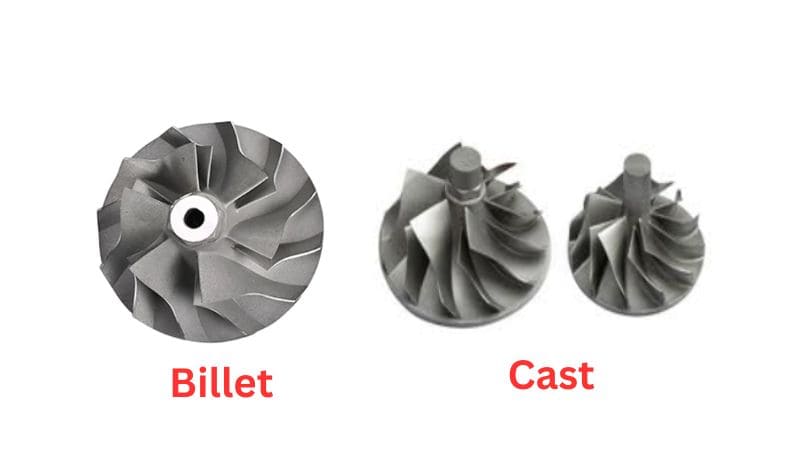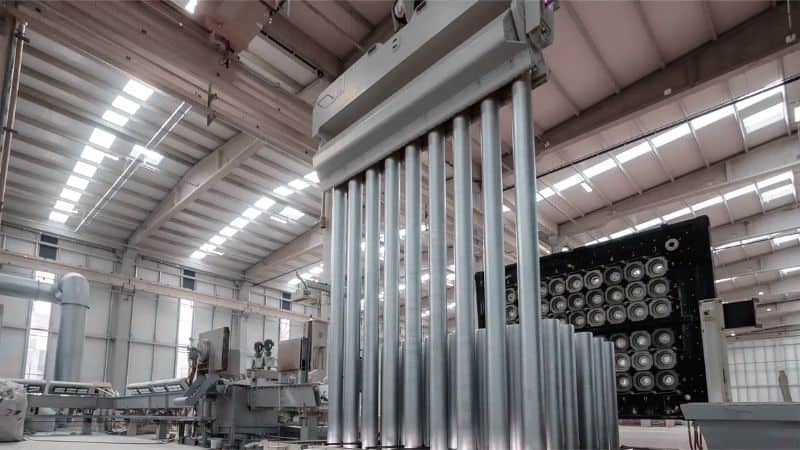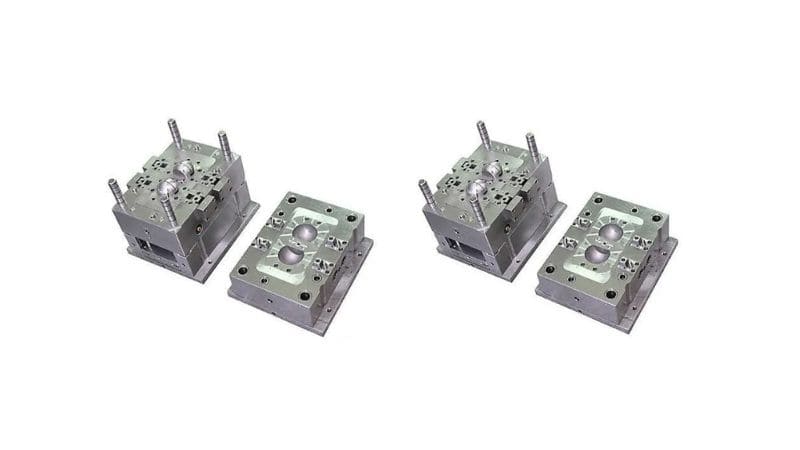
Billet aluminum and cast aluminum represent two distinct approaches to manufacturing high-performance aluminum parts, such as engine blocks, pistons, or gearbox components.
Billet aluminum is a type of metal created by machining a single block of material—typically an alloy—using CNC machines, resulting in parts with superior tensile strength and yield strength compared to cast aluminum. The casting process, like sand casting, involves pouring molten alloy into a mold, forming complex shapes but often yielding less strength due to potential voids or inconsistencies.
In contrast, billet parts are machined from a solid block of material, making them incredibly strong and preferred in automotive and aerospace applications where design precision and overall strength are critical.
While cast parts, such as engine blocks, are cost-effective for mass production, billet aluminum’s manufacturing process eliminates weaknesses inherent to casting, offering a stronger-than-cast alternative.
Forging, another method, can enhance strength, but billet vs. cast debates often center on balancing material used, manufacturing process efficiency, and final performance—proving billet aluminum’s dominance where durability and structural integrity are non-negotiable.
Here is a chart for you to understand better:
| Aspect | Billet Aluminum | Cast Aluminum |
|---|---|---|
| Type of Metal | Machined from a solid block of material (alloy 6061) | Created by pouring molten alloy (e.g., A380) into a mold |
| Manufacturing Process | CNC machine precision machining | Sand casting, die casting, or other molding methods |
| Strength | Higher yield strength (40,000 PSI), uniform grain | Lower yield strength (23,100 PSI), potential porosity |
| Tensile Strength | 45,000 PSI (6061-T6) | 47,000 PSI (A380), but less structural integrity |
| Applications | Aerospace components, precision billet parts, pistons | Engine blocks, gearbox housings, high-volume cast parts |
| Material Used | Single block of raw alloy | Recycled/scrap metal often reused |
| Design Flexibility | Ideal for complex geometries via CNC machining | Suits intricate shapes (e.g., automotive parts) |
| Cost | Higher (labor/material-intensive machining) | Lower for mass production (e.g., automotive cast parts) |
| Defects | Minimal voids; consistent structure | Risk of porosity, inclusions, or air pockets |
| Common Alloys | 6061, 7075 (machinable grades) | A380, A356 (optimized for casting) |
| Key Advantage | Stronger than cast, high precision, durability | Cost-effective, efficient for complex shapes like engine blocks |
What are Billet and Cast Materials?
Billet and cast materials offer different advantages for various applications.
Billet is often praised for its strength and precision, while cast materials are celebrated for their ability to form complex shapes at a lower cost.
Definition of Billet
Billet refers to a solid piece of metal that is cut from a larger block. It is known for its high precision and strength.
Through a process called machining, a billet can be shaped into almost any form you need, making it very versatile. The machining process can involve milling, sawing, or lathing.
One of the major benefits of using billet is its uniform structure. This makes it ideal for applications needing high strength and durability.
Billet materials are often used in industries like aerospace and automotive, where reliability is key. Though more expensive than casting, billet materials provide excellent structural integrity, which can be worth the extra cost in critical applications.
Definition of Cast
Casting involves pouring liquid metal into a mold where it cools and hardens into a desired shape. This method is cost-effective for creating complex shapes that would be difficult to achieve with billet.
Cast materials are useful in producing intricate designs with detailed features.
While casting may not offer the same level of precision as billet, it excels in applications where complex shapes are required. The molds used can vary in material, making casting quite flexible.
Because it is often cheaper, casting is popular for large-scale production of non-critical parts. It allows manufacturers to economize without significantly compromising on quality.
Production Processes

When choosing between billet and cast parts, understanding their production processes is key.
Billets involve precise machining, while casting uses molds to shape metal.
How Billets Are Made
Billet production starts with a solid piece of metal, typically through a process called continuous casting or hot rolling.
The material is then cut into lengths known as billets or bars. These billets are machined using CNC machines or other tools to achieve the desired shape and size.
This subtractive process can be time-consuming but allows for high precision. It’s an excellent choice if you need parts with tight tolerances and strong structural integrity.
Casting Process Explained
Casting involves forming metal by melting it and pouring it into molds. The molten metal fills the mold, taking its shape as it cools and hardens.
This method is considered additive because it builds the shape layer by layer.
Casting is often faster and cheaper for producing high volumes. Potential downsides include lower tensile strength due to possible porosity. Despite this, casting reduces the need for extensive machining afterward, making it perfect for complex shapes and large-scale production.
Material Properties
Billet metal offers superior grain structure, while cast metal provides unique characteristics valuable in certain applications.
Grain Structure in Billet
Billet metal is machined from a solid block. This gives it a consistent grain structure throughout. The continuous grain flow contributes to strength and durability, making billet a popular choice for high-stress applications.
Because billet maintains a homogeneous grain pattern, it minimizes weak points. You might find billet material in precision-engineered parts like aerospace components or high-performance car parts. It excels where reliability and endurance are crucial.
The ability to machine billet into complex shapes is another advantage. You can modify it without significantly affecting its integrity.
Characteristics of Cast Metal
Cast metal is created by pouring molten metal into molds and letting it solidify.
It’s often used in automotive and industrial applications. Due to its manufacturing method, cast metal may have porosity, which can affect its strength. However, it remains suitable for many uses where intricate designs are needed without the stress of heavy loads.
Applications

Billet in Industrial Use
Billet metal is known for its strength and precision. It’s commonly used in machining for creating parts that need to endure high stress and pressure.
You might find billet in heavy machinery, aerospace components, and automotive parts like wheels and suspension parts. It’s also popular for customized items, as it can be precisely machined into unique shapes.
This makes it ideal for industries that value both performance and tailored designs. Its ability to withstand heat and pressure makes billet an excellent choice for critical load-bearing applications.
Common Uses for Cast Metals
Cast metals are invaluable in industries that require complex shapes and large-scale production. You often see cast metal in engine blocks, pipes, and construction parts.
It’s a top choice for plumbing and home fixtures due to its ability to form intricate designs. In the automotive industry, cast components are valued for being strong yet relatively lightweight.
The process of casting allows for a wide range of metal alloys to be used, providing flexibility in manufacturing. Cast metals are also often cost-effective when producing large volumes, making them ideal for commercial goods.
Cost Considerations
Billet Material Cost Analysis
Billet aluminum involves machining a part from a solid block, which makes it more expensive. The precision of this method is high, allowing for detailed specifications.
However, the cost of tools and the time it takes to machine each part add to the expense. If your project needs tight tolerances and you can afford higher costs, billet might be the way to go.
Another factor is the waste produced. Since this process removes material to shape the final part, there can be significant material wastage. This waste contributes to the overall cost, as the leftover material may not be usable.
Consider the high initial expense and ongoing costs when evaluating billet materials.
Casting Cost Effectiveness
Casting involves pouring liquid metal into a mold, which is typically more affordable. This method is efficient for producing multiple parts quickly.
The costs are generally lower because the molds can be reused, and the process is less labor-intensive. For large production runs, casting offers great value for money.
Although casting is cost-effective, it might not offer the same precision as billet. If your project can allow for some variation or if you need a lot of parts, this could be the better choice. Casting is best for budget-conscious projects.
Frequently Asked Questions
What are the differences between billet, cast, and forged materials?
Billet materials are shaped from solid pieces, offering high precision and strength. Cast materials are formed by pouring liquid metal into molds, allowing for complex designs. Forged materials are shaped by hammering or pressing, providing great strength and resilience.
How do billet and cast aluminum compare in terms of performance?
Billet aluminum is typically stronger and provides more precision in its applications. It’s often used in high-performance settings like racing engines.
Cast aluminum can offer more design flexibility and can be more suitable for less demanding, high-volume applications.
Can you explain the cost differences between billet and cast components?
Billet components often come at a higher cost due to the machining required from solid metal. Cast components don’t require as much processing and can be more economical, especially for large production runs.
What are the pros and cons of using billet versus cast materials in manufacturing?
Billet materials offer high strength and precision, making them suitable for performance parts. However, they can be expensive.
Cast materials allow for complex designs and lower costs, but they might not match the strength and precision of billet parts.
How is the strength of billet material different from that of cast products?
Billet materials are generally stronger because they are machined from solid blocks, ensuring a consistent, dense structure. Cast products may have slight variations and potential weaknesses due to the casting process.
In terms of durability, how do billet and cast iron compare?
Billet components are often more durable due to their dense and consistent structure.
Cast iron can be durable as well, but it might have natural weak points due to the casting process.
Your choice depends on the specific application and requirements.
